WMGM102: Zookal Case Study - Decision Making, Teamwork Reflection
VerifiedAdded on 2023/06/11
|8
|1750
|446
Case Study
AI Summary
This analysis focuses on the decision-making processes within Zookal, an Australian business corporation, particularly concerning its CEO Haider's strategies for expansion into the Asia-Pacific markets. The report evaluates Haider's decision-making style, contrasting it with other methodologies such as structured vs. unstructured problem-solving, intuitive vs. rational approaches, and programmed vs. non-programmed decisions. It also examines the factors influencing Haider's decision to scale up versus diversify, including stakeholder influence and cost considerations. The reflection component addresses teamwork, discussing the importance of involvement, essential teamwork skills, common problems encountered in teams, and strategies for resolving conflicts and improving team dynamics. The analysis concludes that effective decision-making is crucial for Zookal's expansion plans, emphasizing the need for efficiency and strategic advancements.

Running Header: Principles of Management
Principles of Management
Authors Name;
Authors ID:
Principles of Management
Authors Name;
Authors ID:
Paraphrase This Document
Need a fresh take? Get an instant paraphrase of this document with our AI Paraphraser
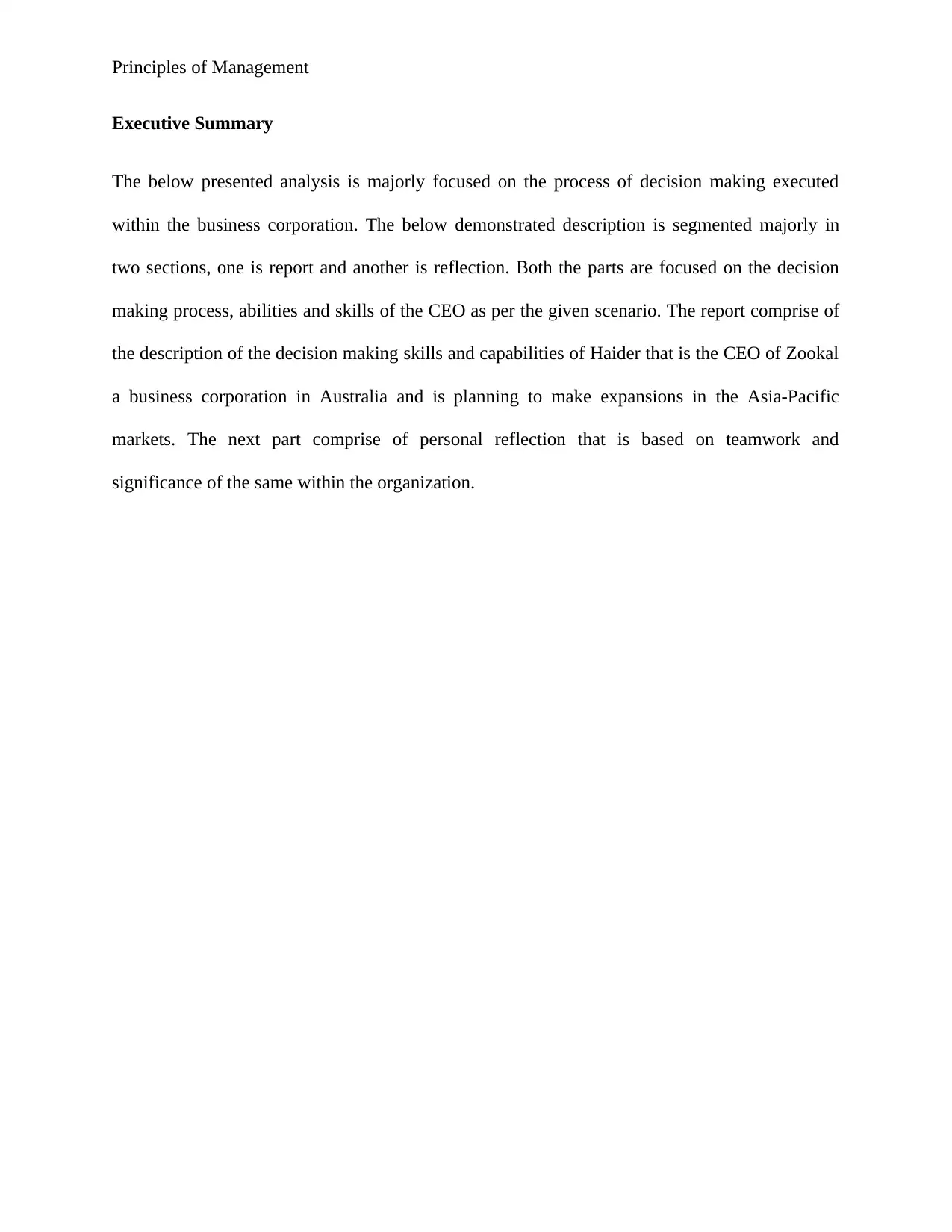
Principles of Management
Executive Summary
The below presented analysis is majorly focused on the process of decision making executed
within the business corporation. The below demonstrated description is segmented majorly in
two sections, one is report and another is reflection. Both the parts are focused on the decision
making process, abilities and skills of the CEO as per the given scenario. The report comprise of
the description of the decision making skills and capabilities of Haider that is the CEO of Zookal
a business corporation in Australia and is planning to make expansions in the Asia-Pacific
markets. The next part comprise of personal reflection that is based on teamwork and
significance of the same within the organization.
Executive Summary
The below presented analysis is majorly focused on the process of decision making executed
within the business corporation. The below demonstrated description is segmented majorly in
two sections, one is report and another is reflection. Both the parts are focused on the decision
making process, abilities and skills of the CEO as per the given scenario. The report comprise of
the description of the decision making skills and capabilities of Haider that is the CEO of Zookal
a business corporation in Australia and is planning to make expansions in the Asia-Pacific
markets. The next part comprise of personal reflection that is based on teamwork and
significance of the same within the organization.

Principles of Management
Contents
Report..............................................................................................................................................4
Type of decision making used by Haider....................................................................................4
A decision to scale up versus diversification...............................................................................5
Who makes the decision in start-up companies...........................................................................6
Reflection.........................................................................................................................................7
Involvement when working in teams...........................................................................................7
Teamwork skills...........................................................................................................................7
Problems in team.........................................................................................................................7
Resolving problems.....................................................................................................................7
The aspect of teamwork to be improved......................................................................................7
Conclusion.......................................................................................................................................7
References........................................................................................................................................9
Contents
Report..............................................................................................................................................4
Type of decision making used by Haider....................................................................................4
A decision to scale up versus diversification...............................................................................5
Who makes the decision in start-up companies...........................................................................6
Reflection.........................................................................................................................................7
Involvement when working in teams...........................................................................................7
Teamwork skills...........................................................................................................................7
Problems in team.........................................................................................................................7
Resolving problems.....................................................................................................................7
The aspect of teamwork to be improved......................................................................................7
Conclusion.......................................................................................................................................7
References........................................................................................................................................9
⊘ This is a preview!⊘
Do you want full access?
Subscribe today to unlock all pages.

Trusted by 1+ million students worldwide
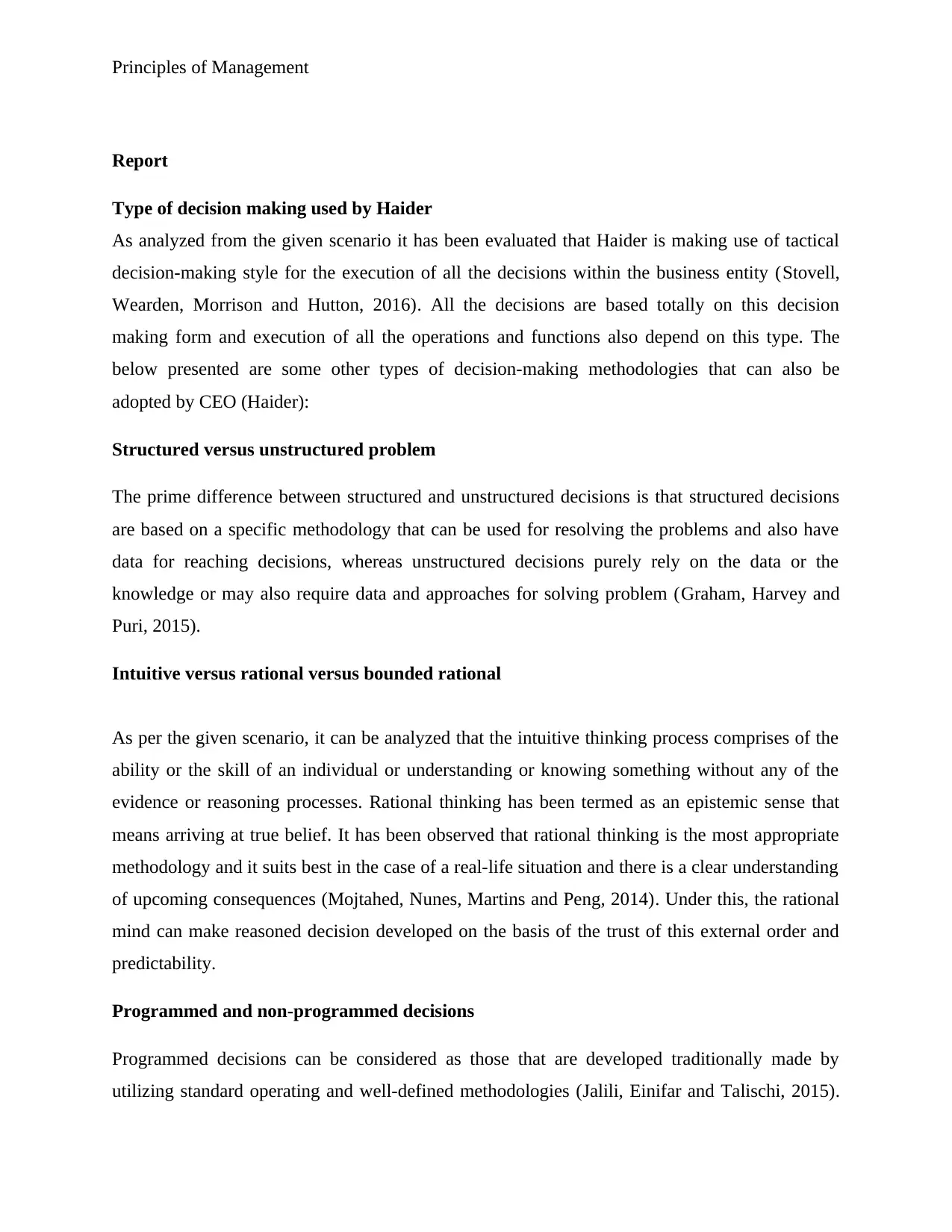
Principles of Management
Report
Type of decision making used by Haider
As analyzed from the given scenario it has been evaluated that Haider is making use of tactical
decision-making style for the execution of all the decisions within the business entity (Stovell,
Wearden, Morrison and Hutton, 2016). All the decisions are based totally on this decision
making form and execution of all the operations and functions also depend on this type. The
below presented are some other types of decision-making methodologies that can also be
adopted by CEO (Haider):
Structured versus unstructured problem
The prime difference between structured and unstructured decisions is that structured decisions
are based on a specific methodology that can be used for resolving the problems and also have
data for reaching decisions, whereas unstructured decisions purely rely on the data or the
knowledge or may also require data and approaches for solving problem (Graham, Harvey and
Puri, 2015).
Intuitive versus rational versus bounded rational
As per the given scenario, it can be analyzed that the intuitive thinking process comprises of the
ability or the skill of an individual or understanding or knowing something without any of the
evidence or reasoning processes. Rational thinking has been termed as an epistemic sense that
means arriving at true belief. It has been observed that rational thinking is the most appropriate
methodology and it suits best in the case of a real-life situation and there is a clear understanding
of upcoming consequences (Mojtahed, Nunes, Martins and Peng, 2014). Under this, the rational
mind can make reasoned decision developed on the basis of the trust of this external order and
predictability.
Programmed and non-programmed decisions
Programmed decisions can be considered as those that are developed traditionally made by
utilizing standard operating and well-defined methodologies (Jalili, Einifar and Talischi, 2015).
Report
Type of decision making used by Haider
As analyzed from the given scenario it has been evaluated that Haider is making use of tactical
decision-making style for the execution of all the decisions within the business entity (Stovell,
Wearden, Morrison and Hutton, 2016). All the decisions are based totally on this decision
making form and execution of all the operations and functions also depend on this type. The
below presented are some other types of decision-making methodologies that can also be
adopted by CEO (Haider):
Structured versus unstructured problem
The prime difference between structured and unstructured decisions is that structured decisions
are based on a specific methodology that can be used for resolving the problems and also have
data for reaching decisions, whereas unstructured decisions purely rely on the data or the
knowledge or may also require data and approaches for solving problem (Graham, Harvey and
Puri, 2015).
Intuitive versus rational versus bounded rational
As per the given scenario, it can be analyzed that the intuitive thinking process comprises of the
ability or the skill of an individual or understanding or knowing something without any of the
evidence or reasoning processes. Rational thinking has been termed as an epistemic sense that
means arriving at true belief. It has been observed that rational thinking is the most appropriate
methodology and it suits best in the case of a real-life situation and there is a clear understanding
of upcoming consequences (Mojtahed, Nunes, Martins and Peng, 2014). Under this, the rational
mind can make reasoned decision developed on the basis of the trust of this external order and
predictability.
Programmed and non-programmed decisions
Programmed decisions can be considered as those that are developed traditionally made by
utilizing standard operating and well-defined methodologies (Jalili, Einifar and Talischi, 2015).
Paraphrase This Document
Need a fresh take? Get an instant paraphrase of this document with our AI Paraphraser
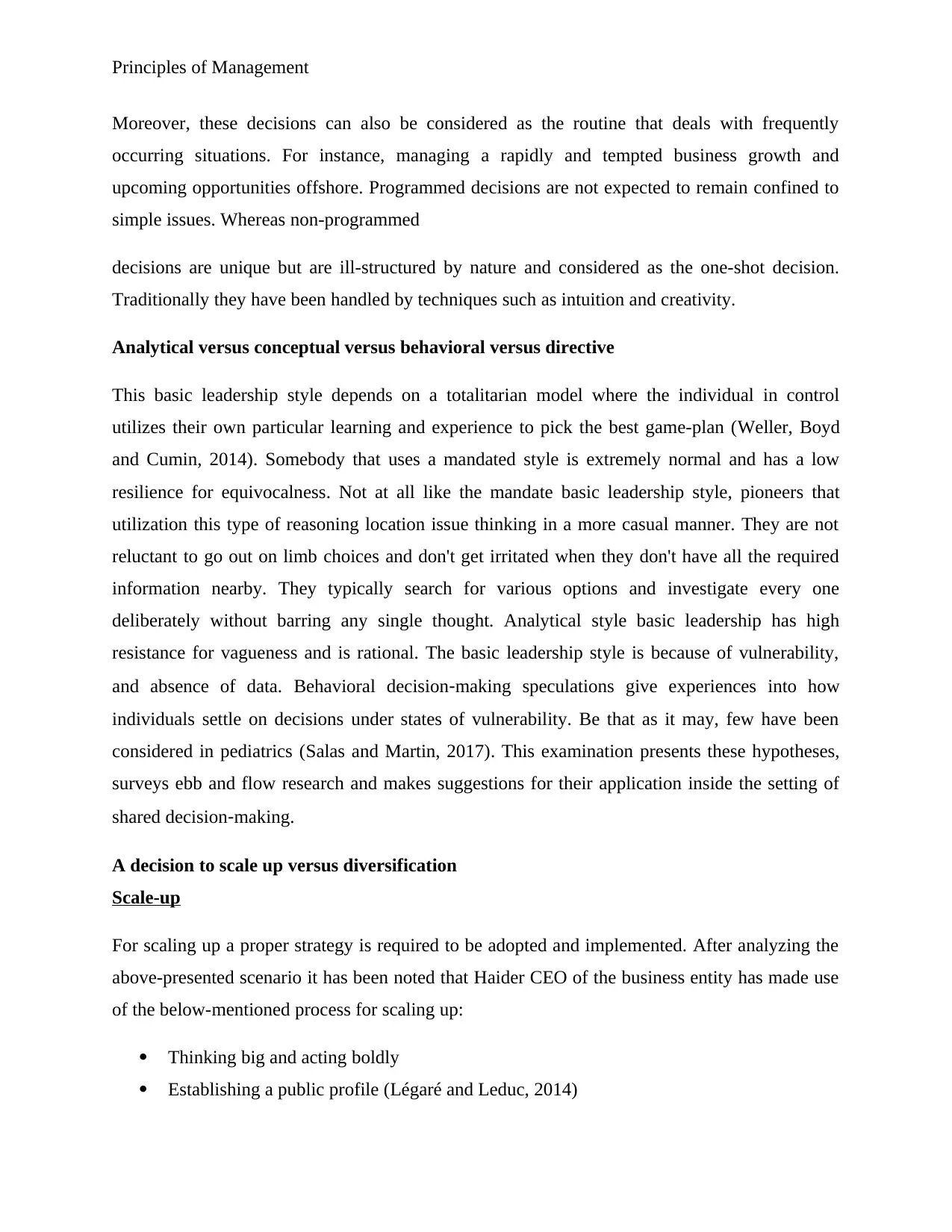
Principles of Management
Moreover, these decisions can also be considered as the routine that deals with frequently
occurring situations. For instance, managing a rapidly and tempted business growth and
upcoming opportunities offshore. Programmed decisions are not expected to remain confined to
simple issues. Whereas non-programmed
decisions are unique but are ill-structured by nature and considered as the one-shot decision.
Traditionally they have been handled by techniques such as intuition and creativity.
Analytical versus conceptual versus behavioral versus directive
This basic leadership style depends on a totalitarian model where the individual in control
utilizes their own particular learning and experience to pick the best game-plan (Weller, Boyd
and Cumin, 2014). Somebody that uses a mandated style is extremely normal and has a low
resilience for equivocalness. Not at all like the mandate basic leadership style, pioneers that
utilization this type of reasoning location issue thinking in a more casual manner. They are not
reluctant to go out on limb choices and don't get irritated when they don't have all the required
information nearby. They typically search for various options and investigate every one
deliberately without barring any single thought. Analytical style basic leadership has high
resistance for vagueness and is rational. The basic leadership style is because of vulnerability,
and absence of data. Behavioral decision‐making speculations give experiences into how
individuals settle on decisions under states of vulnerability. Be that as it may, few have been
considered in pediatrics (Salas and Martin, 2017). This examination presents these hypotheses,
surveys ebb and flow research and makes suggestions for their application inside the setting of
shared decision‐making.
A decision to scale up versus diversification
Scale-up
For scaling up a proper strategy is required to be adopted and implemented. After analyzing the
above-presented scenario it has been noted that Haider CEO of the business entity has made use
of the below-mentioned process for scaling up:
Thinking big and acting boldly
Establishing a public profile (Légaré and Leduc, 2014)
Moreover, these decisions can also be considered as the routine that deals with frequently
occurring situations. For instance, managing a rapidly and tempted business growth and
upcoming opportunities offshore. Programmed decisions are not expected to remain confined to
simple issues. Whereas non-programmed
decisions are unique but are ill-structured by nature and considered as the one-shot decision.
Traditionally they have been handled by techniques such as intuition and creativity.
Analytical versus conceptual versus behavioral versus directive
This basic leadership style depends on a totalitarian model where the individual in control
utilizes their own particular learning and experience to pick the best game-plan (Weller, Boyd
and Cumin, 2014). Somebody that uses a mandated style is extremely normal and has a low
resilience for equivocalness. Not at all like the mandate basic leadership style, pioneers that
utilization this type of reasoning location issue thinking in a more casual manner. They are not
reluctant to go out on limb choices and don't get irritated when they don't have all the required
information nearby. They typically search for various options and investigate every one
deliberately without barring any single thought. Analytical style basic leadership has high
resistance for vagueness and is rational. The basic leadership style is because of vulnerability,
and absence of data. Behavioral decision‐making speculations give experiences into how
individuals settle on decisions under states of vulnerability. Be that as it may, few have been
considered in pediatrics (Salas and Martin, 2017). This examination presents these hypotheses,
surveys ebb and flow research and makes suggestions for their application inside the setting of
shared decision‐making.
A decision to scale up versus diversification
Scale-up
For scaling up a proper strategy is required to be adopted and implemented. After analyzing the
above-presented scenario it has been noted that Haider CEO of the business entity has made use
of the below-mentioned process for scaling up:
Thinking big and acting boldly
Establishing a public profile (Légaré and Leduc, 2014)
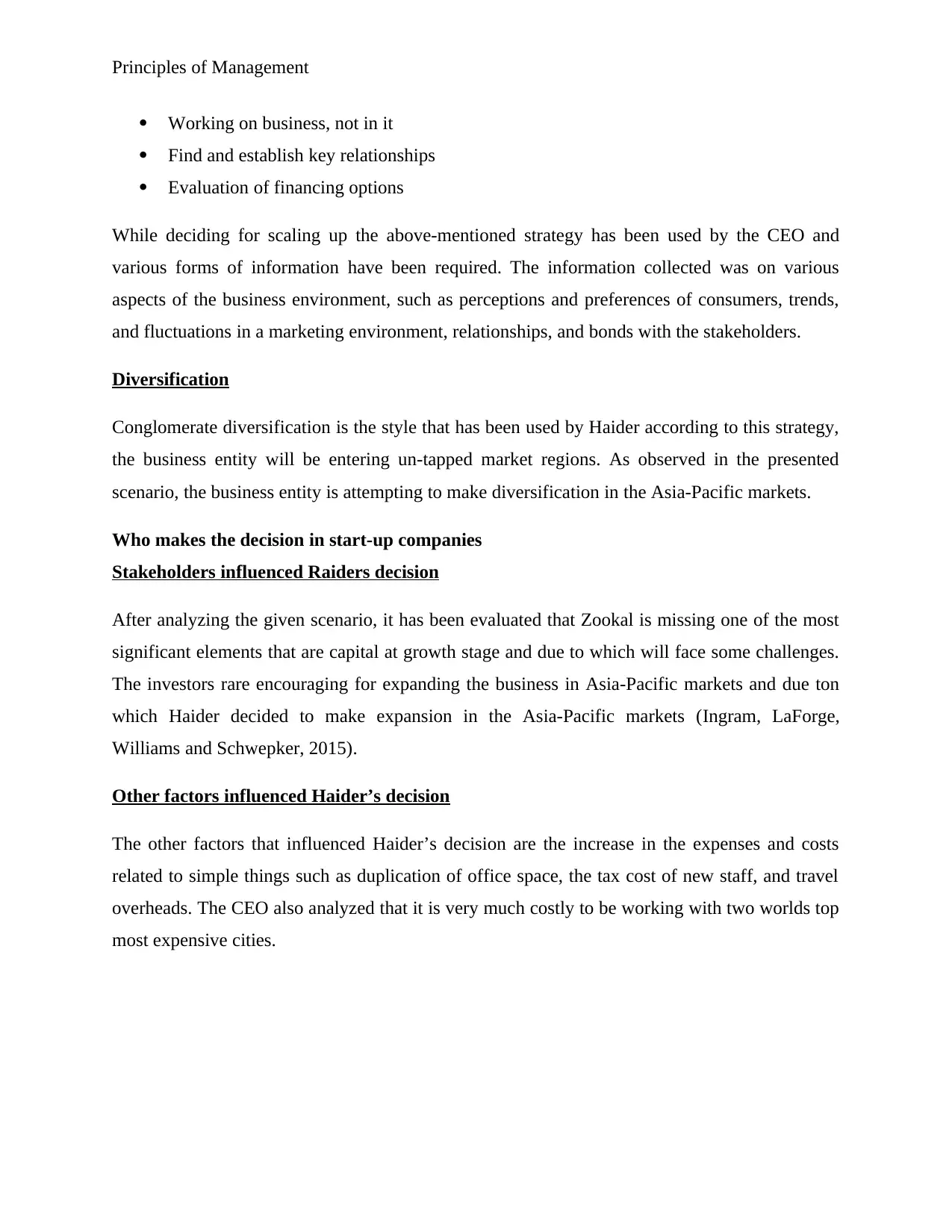
Principles of Management
Working on business, not in it
Find and establish key relationships
Evaluation of financing options
While deciding for scaling up the above-mentioned strategy has been used by the CEO and
various forms of information have been required. The information collected was on various
aspects of the business environment, such as perceptions and preferences of consumers, trends,
and fluctuations in a marketing environment, relationships, and bonds with the stakeholders.
Diversification
Conglomerate diversification is the style that has been used by Haider according to this strategy,
the business entity will be entering un-tapped market regions. As observed in the presented
scenario, the business entity is attempting to make diversification in the Asia-Pacific markets.
Who makes the decision in start-up companies
Stakeholders influenced Raiders decision
After analyzing the given scenario, it has been evaluated that Zookal is missing one of the most
significant elements that are capital at growth stage and due to which will face some challenges.
The investors rare encouraging for expanding the business in Asia-Pacific markets and due ton
which Haider decided to make expansion in the Asia-Pacific markets (Ingram, LaForge,
Williams and Schwepker, 2015).
Other factors influenced Haider’s decision
The other factors that influenced Haider’s decision are the increase in the expenses and costs
related to simple things such as duplication of office space, the tax cost of new staff, and travel
overheads. The CEO also analyzed that it is very much costly to be working with two worlds top
most expensive cities.
Working on business, not in it
Find and establish key relationships
Evaluation of financing options
While deciding for scaling up the above-mentioned strategy has been used by the CEO and
various forms of information have been required. The information collected was on various
aspects of the business environment, such as perceptions and preferences of consumers, trends,
and fluctuations in a marketing environment, relationships, and bonds with the stakeholders.
Diversification
Conglomerate diversification is the style that has been used by Haider according to this strategy,
the business entity will be entering un-tapped market regions. As observed in the presented
scenario, the business entity is attempting to make diversification in the Asia-Pacific markets.
Who makes the decision in start-up companies
Stakeholders influenced Raiders decision
After analyzing the given scenario, it has been evaluated that Zookal is missing one of the most
significant elements that are capital at growth stage and due to which will face some challenges.
The investors rare encouraging for expanding the business in Asia-Pacific markets and due ton
which Haider decided to make expansion in the Asia-Pacific markets (Ingram, LaForge,
Williams and Schwepker, 2015).
Other factors influenced Haider’s decision
The other factors that influenced Haider’s decision are the increase in the expenses and costs
related to simple things such as duplication of office space, the tax cost of new staff, and travel
overheads. The CEO also analyzed that it is very much costly to be working with two worlds top
most expensive cities.
⊘ This is a preview!⊘
Do you want full access?
Subscribe today to unlock all pages.

Trusted by 1+ million students worldwide
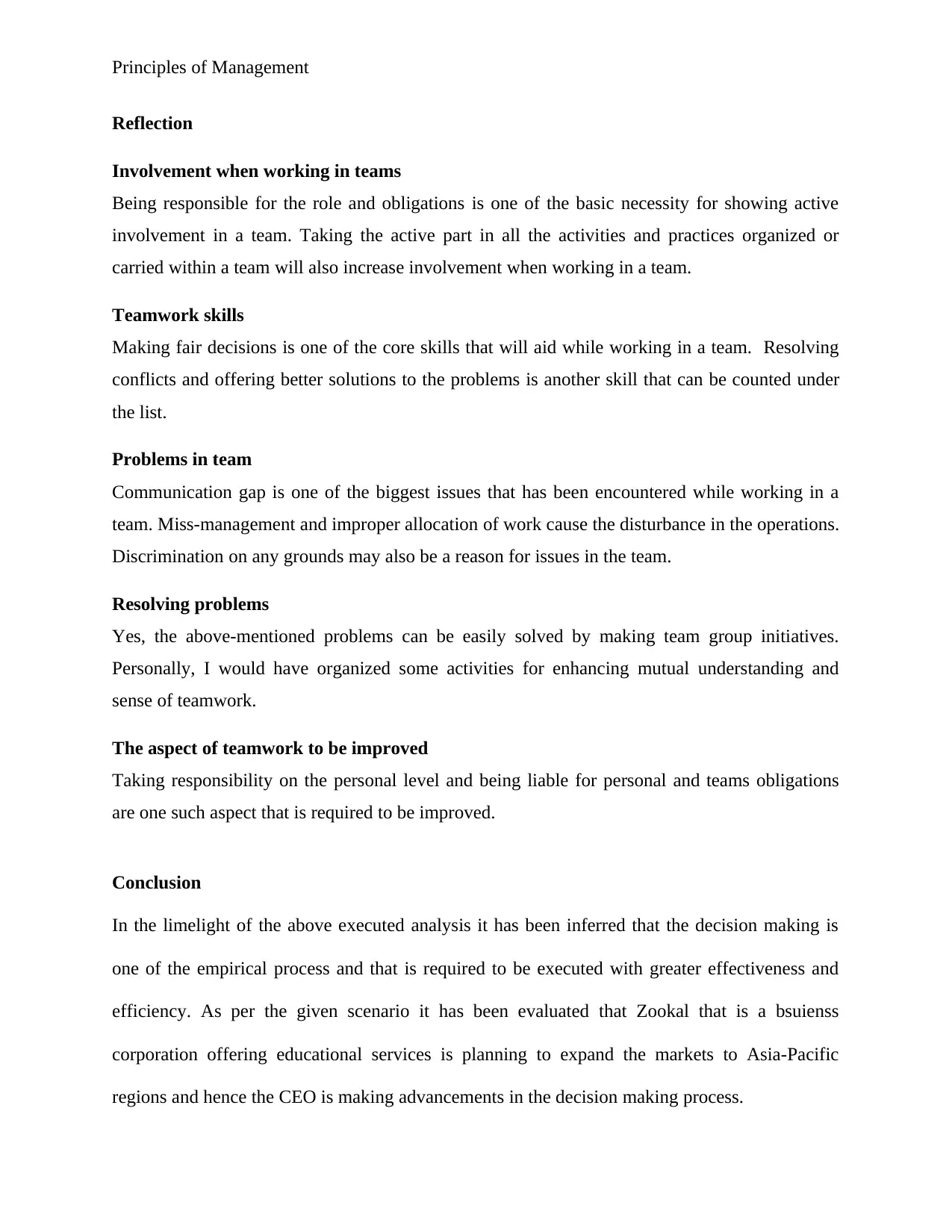
Principles of Management
Reflection
Involvement when working in teams
Being responsible for the role and obligations is one of the basic necessity for showing active
involvement in a team. Taking the active part in all the activities and practices organized or
carried within a team will also increase involvement when working in a team.
Teamwork skills
Making fair decisions is one of the core skills that will aid while working in a team. Resolving
conflicts and offering better solutions to the problems is another skill that can be counted under
the list.
Problems in team
Communication gap is one of the biggest issues that has been encountered while working in a
team. Miss-management and improper allocation of work cause the disturbance in the operations.
Discrimination on any grounds may also be a reason for issues in the team.
Resolving problems
Yes, the above-mentioned problems can be easily solved by making team group initiatives.
Personally, I would have organized some activities for enhancing mutual understanding and
sense of teamwork.
The aspect of teamwork to be improved
Taking responsibility on the personal level and being liable for personal and teams obligations
are one such aspect that is required to be improved.
Conclusion
In the limelight of the above executed analysis it has been inferred that the decision making is
one of the empirical process and that is required to be executed with greater effectiveness and
efficiency. As per the given scenario it has been evaluated that Zookal that is a bsuienss
corporation offering educational services is planning to expand the markets to Asia-Pacific
regions and hence the CEO is making advancements in the decision making process.
Reflection
Involvement when working in teams
Being responsible for the role and obligations is one of the basic necessity for showing active
involvement in a team. Taking the active part in all the activities and practices organized or
carried within a team will also increase involvement when working in a team.
Teamwork skills
Making fair decisions is one of the core skills that will aid while working in a team. Resolving
conflicts and offering better solutions to the problems is another skill that can be counted under
the list.
Problems in team
Communication gap is one of the biggest issues that has been encountered while working in a
team. Miss-management and improper allocation of work cause the disturbance in the operations.
Discrimination on any grounds may also be a reason for issues in the team.
Resolving problems
Yes, the above-mentioned problems can be easily solved by making team group initiatives.
Personally, I would have organized some activities for enhancing mutual understanding and
sense of teamwork.
The aspect of teamwork to be improved
Taking responsibility on the personal level and being liable for personal and teams obligations
are one such aspect that is required to be improved.
Conclusion
In the limelight of the above executed analysis it has been inferred that the decision making is
one of the empirical process and that is required to be executed with greater effectiveness and
efficiency. As per the given scenario it has been evaluated that Zookal that is a bsuienss
corporation offering educational services is planning to expand the markets to Asia-Pacific
regions and hence the CEO is making advancements in the decision making process.
Paraphrase This Document
Need a fresh take? Get an instant paraphrase of this document with our AI Paraphraser
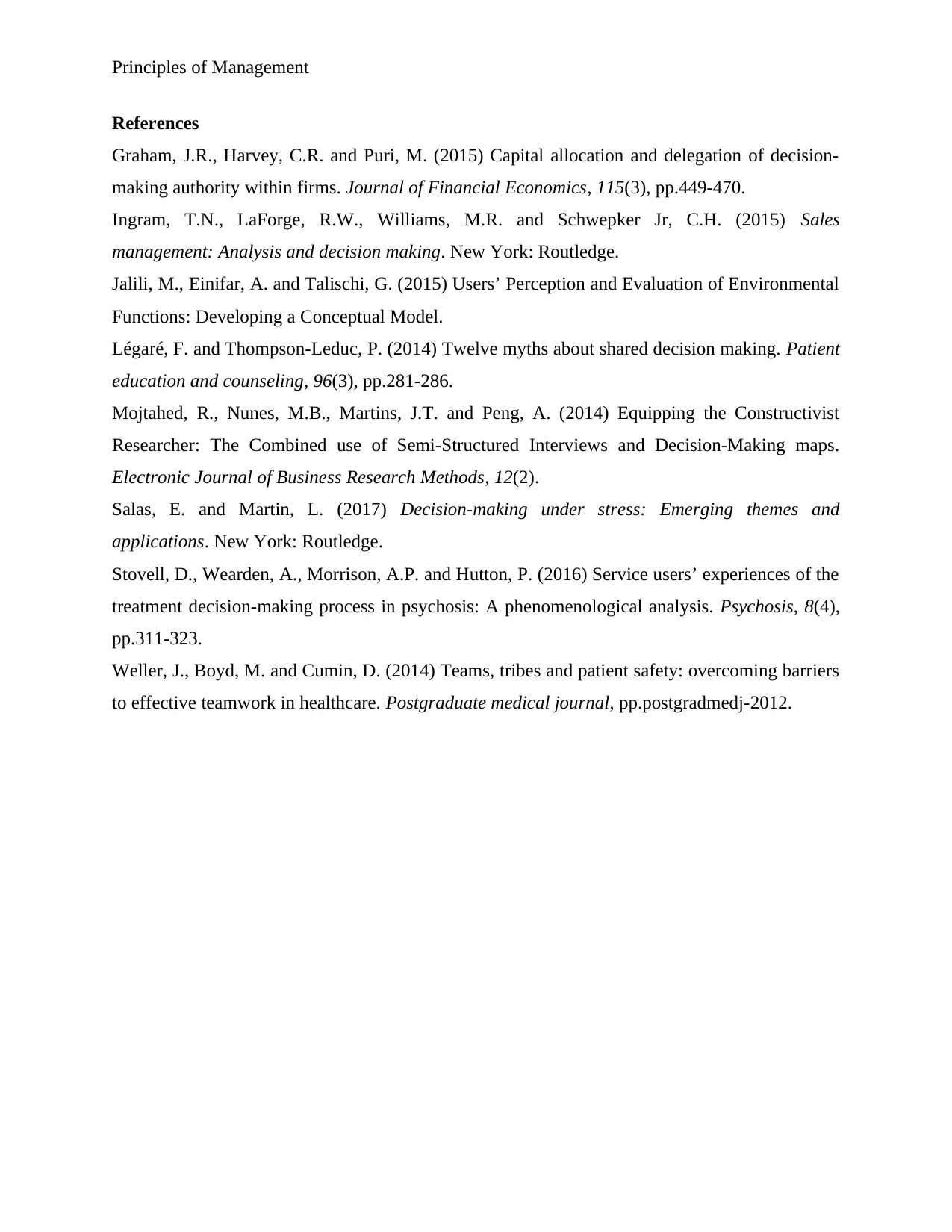
Principles of Management
References
Graham, J.R., Harvey, C.R. and Puri, M. (2015) Capital allocation and delegation of decision-
making authority within firms. Journal of Financial Economics, 115(3), pp.449-470.
Ingram, T.N., LaForge, R.W., Williams, M.R. and Schwepker Jr, C.H. (2015) Sales
management: Analysis and decision making. New York: Routledge.
Jalili, M., Einifar, A. and Talischi, G. (2015) Users’ Perception and Evaluation of Environmental
Functions: Developing a Conceptual Model.
Légaré, F. and Thompson-Leduc, P. (2014) Twelve myths about shared decision making. Patient
education and counseling, 96(3), pp.281-286.
Mojtahed, R., Nunes, M.B., Martins, J.T. and Peng, A. (2014) Equipping the Constructivist
Researcher: The Combined use of Semi-Structured Interviews and Decision-Making maps.
Electronic Journal of Business Research Methods, 12(2).
Salas, E. and Martin, L. (2017) Decision-making under stress: Emerging themes and
applications. New York: Routledge.
Stovell, D., Wearden, A., Morrison, A.P. and Hutton, P. (2016) Service users’ experiences of the
treatment decision-making process in psychosis: A phenomenological analysis. Psychosis, 8(4),
pp.311-323.
Weller, J., Boyd, M. and Cumin, D. (2014) Teams, tribes and patient safety: overcoming barriers
to effective teamwork in healthcare. Postgraduate medical journal, pp.postgradmedj-2012.
References
Graham, J.R., Harvey, C.R. and Puri, M. (2015) Capital allocation and delegation of decision-
making authority within firms. Journal of Financial Economics, 115(3), pp.449-470.
Ingram, T.N., LaForge, R.W., Williams, M.R. and Schwepker Jr, C.H. (2015) Sales
management: Analysis and decision making. New York: Routledge.
Jalili, M., Einifar, A. and Talischi, G. (2015) Users’ Perception and Evaluation of Environmental
Functions: Developing a Conceptual Model.
Légaré, F. and Thompson-Leduc, P. (2014) Twelve myths about shared decision making. Patient
education and counseling, 96(3), pp.281-286.
Mojtahed, R., Nunes, M.B., Martins, J.T. and Peng, A. (2014) Equipping the Constructivist
Researcher: The Combined use of Semi-Structured Interviews and Decision-Making maps.
Electronic Journal of Business Research Methods, 12(2).
Salas, E. and Martin, L. (2017) Decision-making under stress: Emerging themes and
applications. New York: Routledge.
Stovell, D., Wearden, A., Morrison, A.P. and Hutton, P. (2016) Service users’ experiences of the
treatment decision-making process in psychosis: A phenomenological analysis. Psychosis, 8(4),
pp.311-323.
Weller, J., Boyd, M. and Cumin, D. (2014) Teams, tribes and patient safety: overcoming barriers
to effective teamwork in healthcare. Postgraduate medical journal, pp.postgradmedj-2012.
1 out of 8
Related Documents
Your All-in-One AI-Powered Toolkit for Academic Success.
+13062052269
info@desklib.com
Available 24*7 on WhatsApp / Email
![[object Object]](/_next/static/media/star-bottom.7253800d.svg)
Unlock your academic potential
Copyright © 2020–2025 A2Z Services. All Rights Reserved. Developed and managed by ZUCOL.




